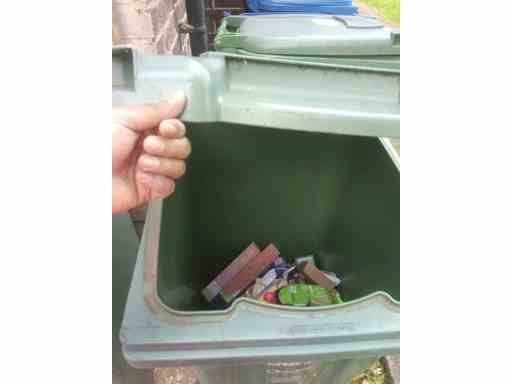Bad Computer 3
Royal Mail Safepalce

(may be a question if this is computing, but I say it is. See the assessment) I bought an item from an online retailer. The seller posted the package as a tracked delivery by Royal Mail. Royal Mail sent me a message saying the package was on it’s way. I knew I wouldn’t be in, but also that I would only be an hour or so late, and assumed if I missed delivery I could pick up from a depot.
When I got back there was no package. When I checked tracking I was told the package had been delivered and that it had been put in a ‘Safeplace’. The ‘Safeplace’ was a green wastebin. Proof of delivery was the photo above.
I tried asking others in the block, but they said they had not seen the parcel. I checked neighbouring bins, in case the delivery driver was dyslexic (is that photo clear? Does it show the package? No). After three days, I and the seller declared the package lost.
The cost
Loss of the item I had bought.
The end
The retailer did not want to pursue Royal Mail. He suggested we split the cost of the loss, which we did. I’ve decided to avoid ordering items to where I live and, with this standard of delivery handling, avoid Royal Mail.
Assessment
The bin in question (a guess) is one of three. The bins are in a carpark. Next to the carpark is a small block of flats, which also have three bins. The bins are sometimes shared, so that’s six green bins—fifteen bins in total. Overlooked directly by sixteen or so residences, not to mention passers by.
Usually, if the situation is personal, I’d give the parties involved a chance to reply. But I can imagine the Royal Mail responses. They’ll range from mission statement, “We endeavour to deliver every package successfully”, to leaning on their performance, “According to our records, the package was delivered on XXX.XX”, to blaming the customer (in this case the receiver i.e. me) “We sent a text message in which you can express delivery preferences”, to legal quibbles, “If there is a problem with a Royal Mail delivery, the seller (not the purchaser) must contact us”, to sales, “If a package is of value, it is possible to purchase insurance against loss of items”.
None of which covers the base query—why did the courier dump a package in a shared wastebin in full sight of a crowd of people? There are posts online expressing surprise that Royal Mail should choose such unsafe ‘Safepoints’, but it’s no surprise at all. It is the sender/seller who must claim, and they have little incentive, as they have no proof of non‐delivery—the receiver may be lying. Moreover a ‘Safepoint’ deposit saves the courier money on return costs, storage, and negotiation communication. So default those Safepoints to anywhere available—why not the local river, shopping mall, council dump or secondhand trader? In this situation, there is no buyer protection at all.
How is this an result of ‘bad computer’? Computers, through various, often high‐tech devices, interact with the real world. Through bar‐code scanning, image recognition, automated package sorting and so forth. Package delivery is a business centred on computing. The modern idea of ‘tracking’ a package, especially to display to a user as information, is only possible using computers. But this case shows it is not computers or the associated machinery that is the problem, it the way people and firms use them.